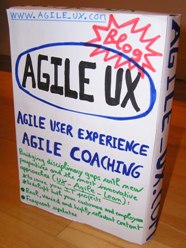Posted by jc-Qualitystreet on 2013/07/30
Changing the culture of an organization is a complex and multifaceted operation that requires a lot of effort: this is why I like the word « transformation » . This transformation can obviously be undertaken from various angles … hacking is one of them.
Hacking is a viral and very relevant approach when it comes to change and improve cultural elements of everyday working-life, like meetings…
Meeting is a strong symbol in organizational culture… and meetings, often seen as waste of time, can be hacked!
Here are the 8 hacks…
See the full article in french on www.qualitystreet.fr
Posted by jc-Qualitystreet on 2011/06/02
Here are the slides (English Version) of the presentation I gave last week at the agile France Conference to introduce Agile & Lean Management with a focus on the role of the Agile Manager:
Posted by jc-Qualitystreet on 2010/12/23
… Because their goal is to create the maximum value for the customer or prospect, as quickly and efficiently as possible;
… Because the Agile and Lean approach is the best way to deliver the right message at the right time to the right person.
Agile marketing is first the realization of IT projects for marketing using agile development… BUT it is also, from another perspective, the adoption of agile values, principles and practices beyond software in Marketing. And that is NEW!
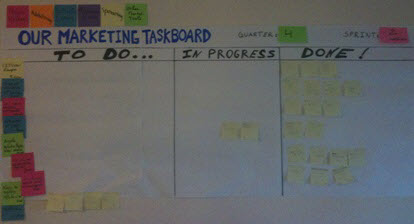
The agile marketing taskboard
After IT teams, this is now the marketing teams who want to become Agile. And some companies have even already taken the opportunity to adopt agility in their own business …
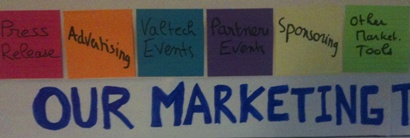
Agile Marketing Themes
The number of examples showing companies applying Agile & Lean practices beyond IT, such as in Communication, Training, Sales, or Marketing increases …
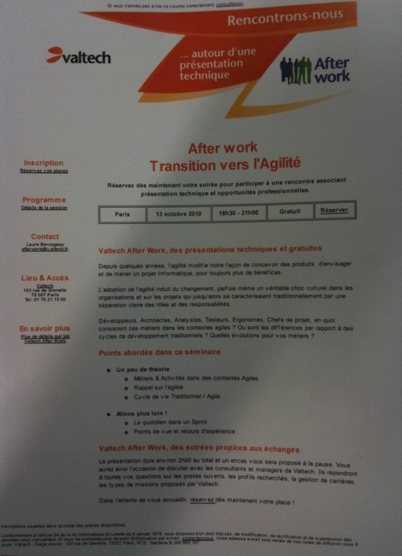
AfterworkAgile: An Agile marketing USER STORY
Via my French blog, I’ve heard about interesting projects outside the context of software development. In addition, my coaching activities enable me to work with Business people (often assigned to the role of Product Owner). Often, these inspiring and smart people quickly detect the potential benefits of Scrum or Kanban, in their daily activities.
See, adopt, adapt and replicate what really works!
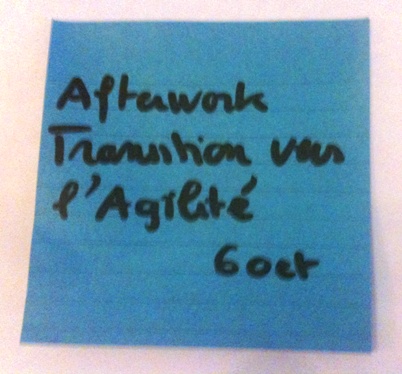
The same user story as a post-it placed in taskboard
The keys of Agile Marketing for marketing teams
- Adopt Agile planning with different levels of details and commitments:
- The Roadmap level (annual)
- The release Level (quarter)
- The Sprint level (with a duration of 3 weeks for Marketing Teams)
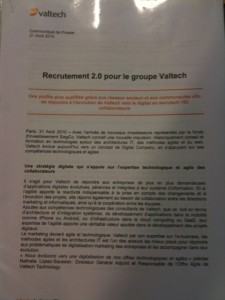
A Press Release User story (item of the sprint)
- Create a Taskboard to visualize and monitor the flow of activity (tasks) during the current Sprint

Taskboard - Quarter - Sprint
- Use visual Management (displaying the taskboard and important marketing tools for a better description, elicitation and understanding)
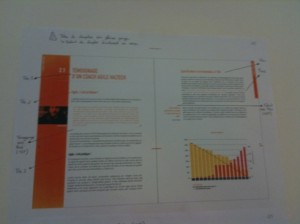
Visual management for marketing actions
- Use short cycles, called sprints. These short period of time (2 or 3 weeks) will also include Scrum ceremonials:
- Planning meeting: 1st day of the Sprint plan for all marketing activities for the next three weeks and the tasks to achieve it
- DailyScrum: Every day in the morning, no more than 10 minutes to synchronize, measure progress and identify impediments
- Sprint Review & Retrospective: Last day of Sprint, to inspect and adapt…
- Focus on Agile values (Courage, Communication, Feedback, Simplicity, Respect) for the team in its way of working together but also in its relations with internal and external partners….
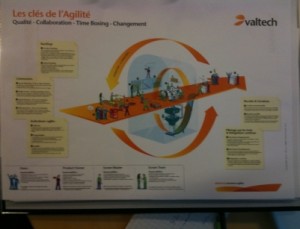
Keys to Agility... not only a User Story 🙂
- Use the user stories (categorized into themes and decomposed tasks that will be moved on the taskboard) for your marketing actions
- Gradually, calibrate your sprints by estimating your user stories, and at the end of each sprint, take the time for continuous reflection and improvement.
Posted by jc-Qualitystreet on 2010/11/15
During an agile transition program, do not let your managers by the roadside! Rather help them to become Agile managers and to control the evolution of their profession.
The « era of management 3.0« (agile and lean) is announced so make the middle manager a key player for change, between opportunity and necessity…
The case of middle management
« Top-Down » or « Bottom-Up », there is no debate anymore. We know today that a top management support and the ownership by the teams are both essential to ensure the success of the transition to agility. No, the issues of the Agile Enterprise are now in intermediate managerial layers of the organization.

Towards an Agile Middle Management
How to approach them? How to convince them? How to transform them?
My experience with Agile projects and agile coaching in various sectors (banking, industry, software vendor …) showed me that this is the middle management that holds the keys to agility on the Long Term. Indeed, middle managers can be the most active supporters or the worst impediment and therefore the most dangerous opponent of the agile transformation.
The opportunity to become an Agile Manager…
With only one goal: the success of teams…
The « Command & Control » management style based on Taylorism and scientific management (OST) has shown its limits… the agile manager explores new dimensions (mostly related to facilitation & leadership) to ensure the success of all. The role within an agile organization becomes a clever trade-off between maintaining / abandoning some responsibilities and acquiring new skills.
So, even if every management role is unique, context-specific, here is the list of the 6 core activities of the Agile manager:
- (Still) Manage the portfolio of projects and coordinate with other managers
- Define projects strategy at the organization level
- Set priorities
- Define budget and resources
- Do the staffing
- Work with peers as a team
- (Still) Manage recruitment
- Hire people
- But also fire and solve potential conflicts
- Support Projects and Agile self-organized Teams
- Promote autonomy and self-organization
- Remove impediments that the team or ScrumMaster are not able to manage
- Manage logistics
- Buy the supplies
- Challenge teams and help them to improve their knowledge about products, tools, technologies, methods…
- Create a relationship of trust, develop (career) and motivate people
- Make yourself available
- Get to know each person and his work
- Facilitate the acquisition of new skills
- Give feedback
- Give work recognition
- Delegate tasks
- (Still) Create an environment for success and energize change
- Communicate the vision
- Give a direction
- Adopt the appropriate management style
- Simplify usage
- Seek performance through appropriate tools and processes based on continuous improvement and waste elimination
- Initiate, support and animate communities of practices
- Give time and resources to agile communities, ScrumMaster, Product Owner, Agile Manager, Architects, UX Groups …,
- Promote communities of practices in the organization
And my role as an Agile Coach?
Engage conversations with managers and support them in their journey toward becoming an AGILE MANAGER !
Posted by jc-Qualitystreet on 2009/11/19
Even if rare examples of « Big Bang » agile adoption exist, as Salesforce in 2007 (not without a very strong preparation), I am convinced that a successful agile transformation requires two or three (max) pilot projects.
REAL PROJECTS, REAL TEAMS: TWO PREREQUISITES.
First, the selected pilot project is an opportunity to change and to learn but it must be also sufficiently representative to be usefull and effective in a transformation approach. Do not experiment what could be agility in real life, do not try agile methods in your own organizational context before a general adoption is a mystery to me. You miss an important source of knowledge, refinement and improvement and also a good opportunity to initiate change management.
BUT HOW TO SELECT THE APPROPRIATE PILOT PROJECTS?
This is a recurrent but crucial and challenging question… Mike Cohn answered it recently by proposing 4 attributes to help the choice. His four criteria suit me well:
- Duration: The ideal pilot project should be neither too short (to be credible, representative and to give a learning opportunity) nor too long (for an effective capitalization and a rapid agile generalization).
In short : Between 2 and 5 months (max) with 4 to 7 iterations
- Size: The ideal pilot project should start with a single, small collocated team. A distributed team or several small teams would add unnecessary complexity during the pilot phase, unless working with distributed teams is the norm within the organization.
In short: One single, small and collocated team
- Importance: Unimportant projects will lead to less commitment and won’t be representative and credible… but critical or top priority projects would entail too much pressure for a team in a leaning situation. A good balance must be found for the ideal pilot project.
In short: Medium importance, not critical but valuable for the organization
- Business sponsor engagement: The ideal pilot project should have an engaged business sponsor. His commitment is a key to remove any obstacles. He will also be the best ambassador to promote the new methodology.
In short: One engaged business sponsor
In summary, to launch an agile transformation, the ideal pilot project is both:
1. A real project with a real team
3. A project of a duration of 2 to 5 months (max), for example with 4 to 7 iterations
4. A project with a single, small and collocated team
5. A medium priority and non critical project but valuable for the organization
6. A project with an engaged business sponsor










